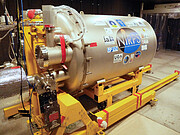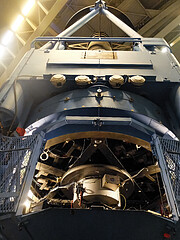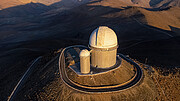Mitteilung
Ein neuer Planetenjäger erwacht: Das NIRPS-Instrument sieht sein erstes Licht
27. Juni 2022
Der Near InfraRed Planet Searcher (NIRPS), der am 3,6-Meter-Teleskop der ESO am La-Silla-Observatorium in Chile montiert ist, hat erfolgreich seine ersten Beobachtungen durchgeführt. Seine Aufgabe ist die Suche nach neuen Exoplaneten um die kühlsten Sterne der Milchstraße.
"NIRPS war lange in Planung, und ich bin begeistert, wie diese Mission sich entwickelt hat", kommentiert René Doyon, Direktor des Institute for Research on Exoplanets an der Universität Montréal und Ko-Projektleiter von NIRPS. "Dieses unglaubliche Infrarot-Instrument wird uns helfen, die unserem unserem Sonnensystem am nächsten gelegenen bewohnbaren Welten zu finden."
Das Instrument wird sich bei seiner Suche auf felsige Welten konzentrieren, die für das Verständnis der Entstehung und Entwicklung von Planeten von zentraler Bedeutung sind und auf denen sich am ehesten Leben entwickeln kann. NIRPS wird nach solchen Gesteinsplaneten in der Umgebung von kleinen, kühlen roten Zwergsternen suchen - der häufigsten Art von Sternen in unserer Milchstraße, deren Masse etwa zwei bis zehn Mal kleiner ist als die unserer Sonne.
NIRPS wird mit Hilfe der Radialgeschwindigkeitsmethode nach Exoplaneten suchen. Wenn ein Planet einen Stern umkreist, führt seine Anziehungskraft dazu, dass der Stern leicht "wackelt", wodurch sein Licht rot- oder blauverschoben wird, wenn er sich von der Erde weg oder auf sie zu bewegt. Durch die Messung der subtilen Veränderungen im Licht des Sterns wird NIRPS den Astronom*innen helfen, die Masse des Planeten und andere Eigenschaften zu bestimmen.
NIRPS wird im nahen Infrarot nach diesen spektralen Schwankungen suchen, da dies der Hauptwellenlängenbereich ist, der von diesen kleinen, kühlen Sternen abgestrahlt wird. NIRPS wird zusammen mit dem High Accuracy Radial velocity Planet Searcher (HARPS) auf der Suche nach neuen felsigen Welten eingesetzt. HARPS, der seit 2003 am 3,6-Meter-Teleskop der ESO am La-Silla-Observatorium in Chile installiert ist, verwendet ebenfalls die Radialgeschwindigkeitsmethode, arbeitet aber im sichtbaren Licht. Der gleichzeitige Einsatz beider Instrumente wird eine umfassendere Analyse dieser Gesteinswelten ermöglichen.
"NIRPS ergänzt HARPS optimal, da er Wellenlängen im nahen Infrarot abdeckt", erklärt Céline Peroux, ESO-Projektwissenschaftlerin für NIRPS. "Das ist ideal, um erdähnliche Exoplaneten um rötlichere Sterne zu beobachten."
Ein weiterer wesentlicher Unterschied zwischen den beiden Instrumenten besteht darin, dass das NIRPS mit einem leistungsstarken System adaptiver Optik ausgestattet ist. Die adaptive Optik ist eine Technik, die die Auswirkungen atmosphärischer Turbulenzen korrigiert, die das Funkeln von Sternen verursachen. Durch den Einsatz dieser Technik wird NIRPS seine Effizienz bei der Suche und Untersuchung von Exoplaneten mehr als verdoppeln.
"NIRPS gehört zu den wenigen leistungsstarken Spektrografen für das nahe Infrarot und wird voraussichtlich eine Schlüsselrolle bei Beobachtungen in Synergie mit Weltraummissionen wie dem James Webb Space Telescope und bodengebundenen Observatorien spielen", fügt François Bouchy von der Universität Genf in der Schweiz und Ko-Projektleiter von NIRPS hinzu.
Die mit NIRPS und HARPS gemachten Entdeckungen werden von einigen der leistungsstärksten Observatorien der Welt nachbeobachtet, zum Beispiel das Very Large Telescope der ESO und das kommenden Extremely Large Telescope in Chile (für das ähnliche Instrumente in der Entwicklung sind). Durch die Zusammenarbeit mit weltraum- und bodengebundenen Observatorien wird NIRPS in der Lage sein, Hinweise auf die Zusammensetzung eines Exoplaneten zu sammeln und sogar nach Anzeichen von Leben in seiner Atmosphäre zu suchen.
NIRPS wurde von einer internationalen Kollaborationt unter der Leitung des Institute for Research on Exoplanets an der Université de Montréal in Kanada und des Observatoire Astronomique de l'Université de Genève in der Schweiz entwickelt.
Weitere Informationen
Die am NIRPS-Konsortium beteiligten Institute sind die Université de Montréal in Kanada, das Observatoire Astronomique der Université de Genève in der Schweiz, das Instituto de Astrofísica e Ciências do Espaço an den Universitäten Porto und Lissabon in Portugal, das Instituto de Astrofísica de Canarias in Spanien, die Université de Grenoble in Frankreich und die Universidade Federal do Rio Grande do Norte in Brasilien.
Kontaktinformationen
François Bouchy
Observatoire Astronomique de l’Université de Genève
Tel.: +41 22 37 92 460
E-Mail: francois.bouchy@unige.ch
René Doyon
Institute for Research on Exoplanets — Université de Montréal
Tel: +1 514 343 6111 x3204
E-Mail: rene.doyon@umontreal.ca
Celine Peroux
ESO Project Scientist for NIRPS
Tel.: +49 89 3200 6346
Email: cperoux@eso.org
Norbert Hubin
ESO Project Manager & Engineer for NIRPS
Tel.: +49 89 3200 6517
E-Mail: nhubin@eso.org
Bárbara Ferreira
ESO Media Manager
Garching bei München
Tel.: +49 89 3200 6670
E-Mail: press@eso.org
Über die Mitteilung
| ID: | ann22009 |
Our use of Cookies
We use cookies that are essential for accessing our websites and using our services. We also use cookies to analyse, measure and improve our websites’ performance, to enable content sharing via social media and to display media content hosted on third-party platforms.
ESO Cookies Policy
The European Organisation for Astronomical Research in the Southern Hemisphere (ESO) is the pre-eminent intergovernmental science and technology organisation in astronomy. It carries out an ambitious programme focused on the design, construction and operation of powerful ground-based observing facilities for astronomy.
This Cookies Policy is intended to provide clarity by outlining the cookies used on the ESO public websites, their functions, the options you have for controlling them, and the ways you can contact us for additional details.
What are cookies?
Cookies are small pieces of data stored on your device by websites you visit. They serve various purposes, such as remembering login credentials and preferences and enhance your browsing experience.
Categories of cookies we use
Essential cookies (always active): These cookies are strictly necessary for the proper functioning of our website. Without these cookies, the website cannot operate correctly, and certain services, such as logging in or accessing secure areas, may not be available; because they are essential for the website’s operation, they cannot be disabled.
Functional Cookies: These cookies enhance your browsing experience by enabling additional features and personalization, such as remembering your preferences and settings. While not strictly necessary for the website to function, they improve usability and convenience; these cookies are only placed if you provide your consent.
Analytics cookies: These cookies collect information about how visitors interact with our website, such as which pages are visited most often and how users navigate the site. This data helps us improve website performance, optimize content, and enhance the user experience; these cookies are only placed if you provide your consent. We use the following analytics cookies.
Matomo Cookies:
This website uses Matomo (formerly Piwik), an open source software which enables the statistical analysis of website visits. Matomo uses cookies (text files) which are saved on your computer and which allow us to analyze how you use our website. The website user information generated by the cookies will only be saved on the servers of our IT Department. We use this information to analyze www.eso.org visits and to prepare reports on website activities. These data will not be disclosed to third parties.
On behalf of ESO, Matomo will use this information for the purpose of evaluating your use of the website, compiling reports on website activity and providing other services relating to website activity and internet usage.
Matomo cookies settings:
Additional Third-party cookies on ESO websites: some of our pages display content from external providers, e.g. YouTube.
Such third-party services are outside of ESO control and may, at any time, change their terms of service, use of cookies, etc.
YouTube: Some videos on the ESO website are embedded from ESO’s official YouTube channel. We have enabled YouTube’s privacy-enhanced mode, meaning that no cookies are set unless the user actively clicks on the video to play it. Additionally, in this mode, YouTube does not store any personally identifiable cookie data for embedded video playbacks. For more details, please refer to YouTube’s embedding videos information page.
Cookies can also be classified based on the following elements.
Regarding the domain, there are:
- First-party cookies, set by the website you are currently visiting. They are stored by the same domain that you are browsing and are used to enhance your experience on that site;
- Third-party cookies, set by a domain other than the one you are currently visiting.
As for their duration, cookies can be:
- Browser-session cookies, which are deleted when the user closes the browser;
- Stored cookies, which stay on the user's device for a predetermined period of time.
How to manage cookies
Cookie settings: You can modify your cookie choices for the ESO webpages at any time by clicking on the link Cookie settings at the bottom of any page.
In your browser: If you wish to delete cookies or instruct your browser to delete or block cookies by default, please visit the help pages of your browser:
Please be aware that if you delete or decline cookies, certain functionalities of our website may be not be available and your browsing experience may be affected.
You can set most browsers to prevent any cookies being placed on your device, but you may then have to manually adjust some preferences every time you visit a site/page. And some services and functionalities may not work properly at all (e.g. profile logging-in, shop check out).
Updates to the ESO Cookies Policy
The ESO Cookies Policy may be subject to future updates, which will be made available on this page.
Additional information
For any queries related to cookies, please contact: pdprATesoDOTorg.
As ESO public webpages are managed by our Department of Communication, your questions will be dealt with the support of the said Department.





